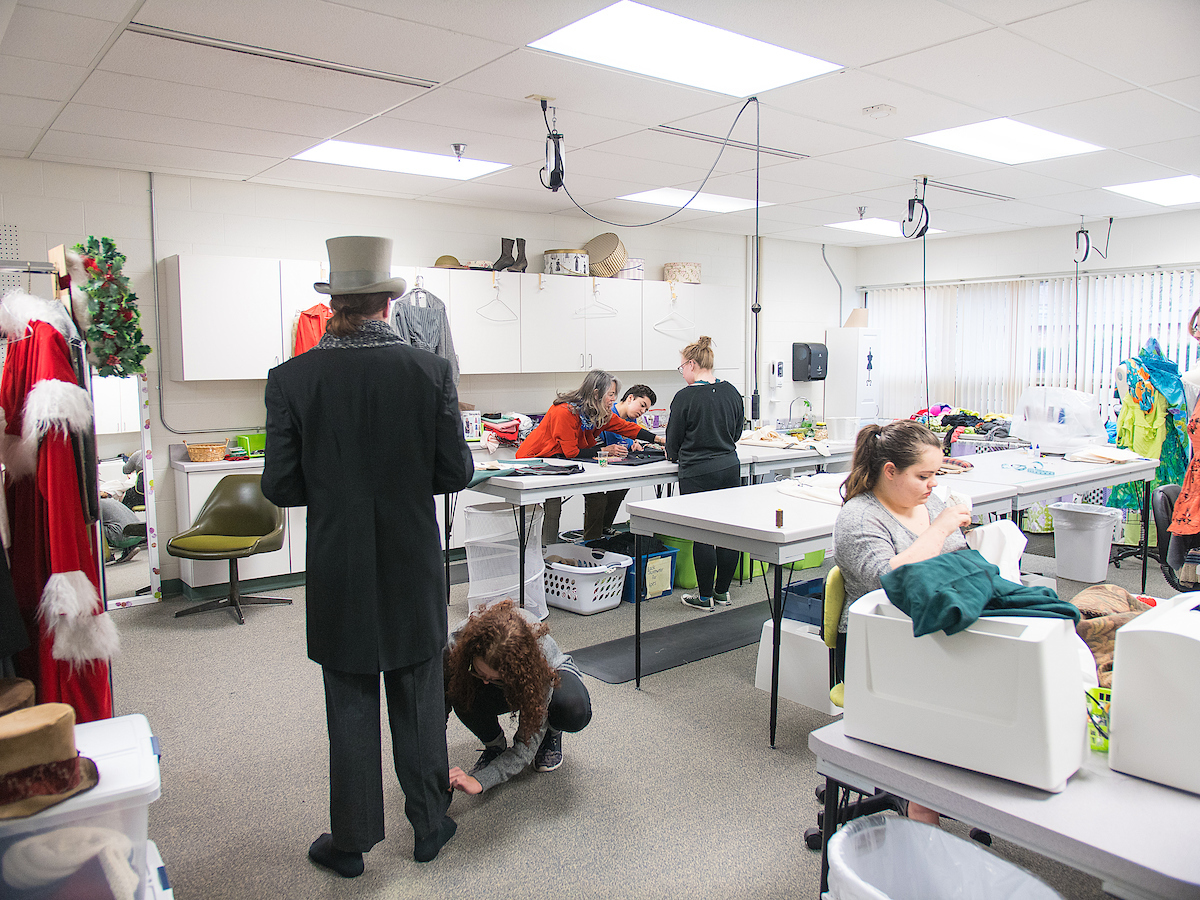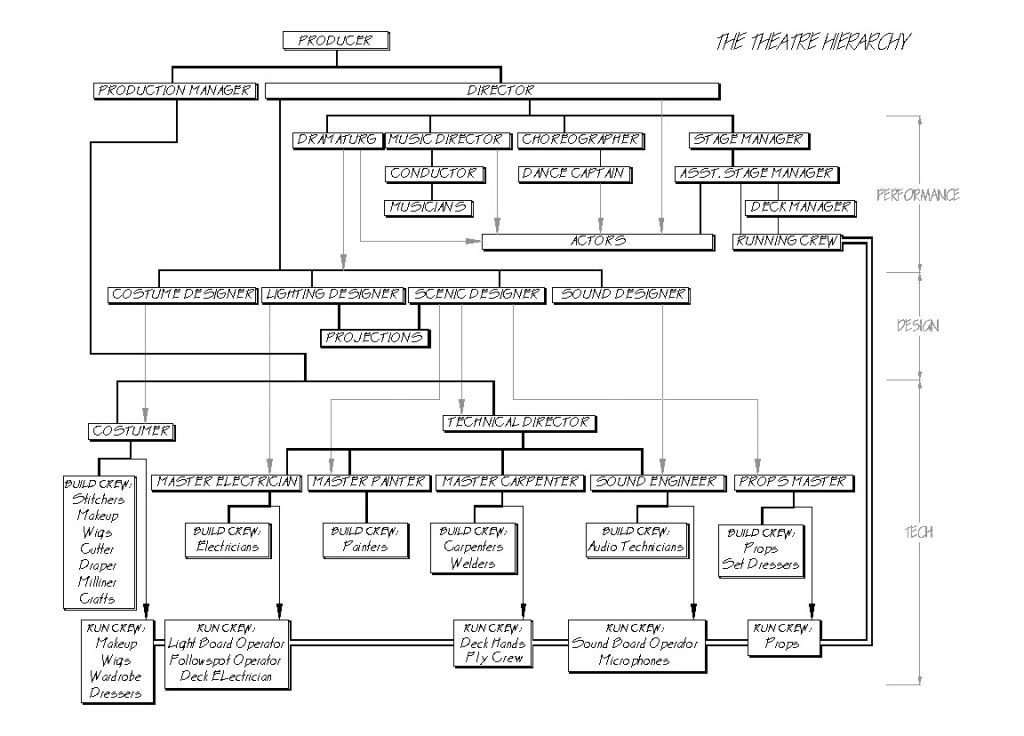1 The University Costume Shop
Supporting Storytelling Through Technology and Teamwork

Learning Outcomes
By the end of this chapter, you should be able to:
- Describe the purpose and function of a costume shop in university theatre.
- Identify key personnel and their roles in costume production.
- Understand how the costume shop fits into the overall production process.
- Explain basic safety and etiquette expectations in the costume shop.
- Describe the core values that guide costume technology work.
- Recognize how costume technology supports creative vision and production demands.
The Mission of the Costume Shop
The costume shop enables costume designs to move from concept to reality, supporting the artistic vision of a production. It serves as a vital link between the designer’s ideas and their execution on stage, ensuring that costumes meet both aesthetic and functional demands for performance.
At the same time, the costume shop provides a learning lab where students build foundational skills in hand sewing, machine sewing, fitting, construction, and wardrobe maintenance. It fosters collaboration, craftsmanship, problem-solving, and professional habits such as safety, organization, and time management, preparing students for internships, summer stock, or professional work.
Where the Costume Shop Fits in the Production Process
- The costume shop works alongside scenic, lighting, sound, props, and stage management teams.
- It serves as the bridge between costume design and performance, managing construction, fitting, maintenance, and dressing of costumes.
- Often works under the guidance of:
- Costume Designer
- Costume Shop Manager (sometimes referred to as “Costumer”)
- Wardrobe Supervisor during production runs.
Once the costume design is finalized, costume technology work moves through two distinct phases: the build phase, which covers everything leading up to the show, and the production phase, which focuses on implementing and managing the costumes during the run.


Collaboration and Costume Technology
Production Hierarchy and the Costume Shop’s Role
The creation of a theatrical production is a collaborative effort involving a wide range of artistic, technical, and management professionals. The chart below outlines how these roles interconnect, from the producer and director who guide the overall vision, to designers, technicians, and performers who bring that vision to life. Each level of this structure plays a vital part in ensuring a successful production, with clear lines of communication and responsibility.
Within this hierarchy, the costume shop is a key component of the design and technical branches. Led by the costume designer and supported by the costumer and a team of skilled artisans—including stitchers, cutters, wig makers, and craftspeople—the costume shop transforms costume designs into reality. The shop’s work not only supports the visual storytelling but also ensures that costumes function effectively for performance. The wardrobe and makeup running crew further ensure that costumes, wigs, and makeup are maintained and managed during each performance, contributing to the seamless operation of the production.
Clear communication is essential for meeting deadlines and making sure costumes support the show’s vision. The process starts with the costume designer, who works with the director and design team to set the creative direction. The designer shares this vision with the costume shop manager. The shop manager runs the daily work of the shop, assigns tasks, and keeps track of progress.
The shop manager talks regularly with the cutters, stitchers, and craftspeople who build the costumes and do fittings. During technical rehearsals and performances, the wardrobe supervisor and crew take care of the costumes, handle quick changes, and report any problems to the shop. This teamwork and steady flow of information help keep the production on track, safe, and successful.
Communication Flow in the Costume Shop
Clear communication between the designer, shop manager, and production team ensures costumes are delivered on time and meet artistic and functional needs. The designer sets the vision, the shop manager coordinates daily work, and the wardrobe team ensures smooth performance operations — all working together to support the production.

Roles and Responsibilities
In a professional costume shop, there may be many more specialized roles, such as someone who handles all the purchasing or one person responsible for any dye and paint work. In a smaller shop such as the one at Colorado Mesa University, one person or position may take on several roles. The following are the ones we most often assign:
Design and Management
- Costume Designer: Designs costumes, collaborates with director, oversees design realization
- Assistant Designer: Helps with research, swatching, paperwork, fittings, and tracking builds.
- Costume Shop Manager: Oversees daily operations, staff hiring and teaching, safety, purchasing, and workflow
Construction
- Cutter/Draper: Develops patterns, fits garments
- Stitcher/Seamstress: Constructs and alters costumes
- Milliner: Designs and constructs hats and headpieces
- Craftsperson: Builds costume crafts such as armor, jewelry, and specialty accessories. Conducts dye and paintwork, including distressing
Hair and Makeup
- Wig Designer/Stylist: Designs, builds, and styles wigs, facial hair, and hairpieces for characters
- Makeup Designer: Designs and creates a makeup plan, schematics, and research for characters.
Wardrobe Operations
- Wardrobe Supervisor: Manages costumes during tech, dress rehearsals, and performances
- Wig/Makeup/Wardrobe Crew: Assists with application, maintenance, and quick changes
Costume Shop Organization
The costume shop at Colorado Mesa University is organized to support both efficient workflow and educational use, with dedicated spaces for design, construction, storage, and maintenance.
Upstairs work area:
The primary workspace includes large cutting and patterning tables, an ironing table equipped with two industrial gravity-fed irons, and sewing stations with up to twelve domestic sewing machines. A designated serger area houses two sergers for finishing seams. The shop provides access to essential drafting and sewing tools, frequently used fabric stock, common trims, labeling materials, and draping mannequins. A computer and printer support pattern drafting and paperwork, while wig supplies and a styling station are available for hair and wig work. Racks hold costumes currently in production for the season’s shows, keeping them organized and accessible. The upper level may be accessed by stair or lift chair.
Downstairs storage and support spaces:
The lower level contains the costume stock, carefully sorted by period and garment type, along with overflow storage for large bolt and upholstery fabrics, trims, and bulk notions such as zippers. This level also includes a craft room for specialized work, a laundry room equipped with a dye-friendly washing machine, and a private fitting room to support performers’ comfort during costume adjustments. A detailed map of costume stock organization is available.
Emergency Exits:
There are 3 exits from the lower level of the costume shop:
- the elevator
- staircase door next to the elevator which empties into the elevator annex with doors either into the East hallway or outdoors to 12th Street.
- the exterior fire stair exit next to the fitting rooms which empties into the 12th Street rear parking lot
Core Values of the Costume Shop
-
Prioritize safety in all activities.
-
Embrace education: be both a learner and a teacher.
-
Show respect for tools, materials, and colleagues.
-
Practice sustainability and resourcefulness by using materials efficiently and minimizing waste.
-
Take pride in craftsmanship.
-
Demonstrate commitment to supporting the production as a whole.
Shop Safety Rules
- Always wear closed-toe, low heeled shoes in the shop. You may have to climb ladders!
- Keep work areas clean and free of hazards.
- Use tools and equipment only as trained.
- Report damaged equipment or unsafe conditions immediately.
- Know the location of fire extinguishers and first aid kits.
- Water only, in a closed container.
- One earbud only and ask first.
- Unsure? ASK!
Shop Etiquette
- Clock in and out.
- Leave backpacks and coats in designated area.
- Mobile phones should be silenced and used only for work purposes during shop hours.
- Respect shared tools and return them to their proper place.
- Maintain a quiet, focused work environment. Learn to talk AND work.
- Communicate clearly and kindly with coworkers.
- If you’ve finished one job, ask for another.
- Be receptive to feedback and ask questions when unsure.
- Support a positive and inclusive atmosphere. Address colleagues by their preferred names/pronouns and take correction gracefully when given.
- Speak respectfully of all persons and bodies.
- EVERYONE cleans up at the end of the work day.
- Respect the vault – costume shops deal with sensitive private information – honor that.
Chapter Summary
Clear communication is essential for meeting deadlines and making sure costumes support the show’s vision. The process starts with the costume designer, who works with the director and design team to set the creative direction. The designer shares this vision with the costume shop manager. The shop manager runs the daily work of the shop, assigns tasks, and keeps track of progress.
The shop manager talks regularly with the cutters, stitchers, and craftspeople who build the costumes and do fittings. During technical rehearsals and performances, the wardrobe supervisor and crew take care of the costumes, handle quick changes, and report any problems to the shop. This teamwork and steady flow of information help keep the production on track, safe, and successful.
